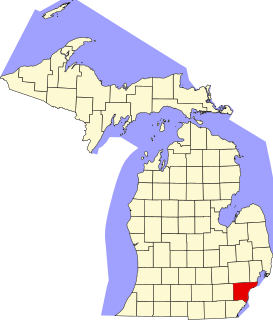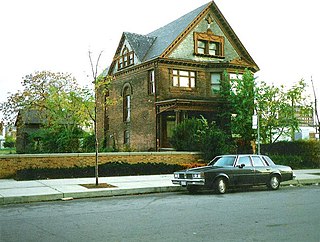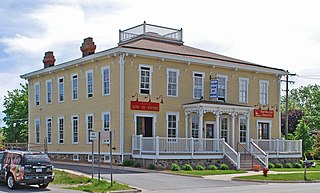
Scouting in Arkansas has a long history, from 1913 to the present day, serving thousands of youth in programs that suit the environment in which they live.

The Second Baptist Church, located at 441 Monroe Street within Greektown in Detroit, Michigan, is the oldest African-American church in the Midwestern United States. It was designated a Michigan State Historic Site in 1974 listed on the National Register of Historic Places in 1975.

Bay View is an unincorporated resort community and census designated place (CDP) in the U.S. state of Michigan. It is located in Bear Creek Township, Emmet County on Little Traverse Bay and abuts the east side of the city of Petoskey along U.S. Highway 31. The ZIP code is 49770 and the FIPS place code is 06260. It was originally formed as part of the Methodist Camp Meeting movement and in 1886 the Chautauqua movement added. As of the 2010 census the population of the CDP was 133. Bay View is incorporated as a domestic nonprofit organization under Act 39 of the Public Acts of 1899, being MCL 455.51. Act 39 of the Public Acts of 1899 establishes Bay View as a body politic and corporate.

Cass Lake is on the main branch of the Clinton River.

SS. Cyril and Methodius Seminary is a four-year private Polish seminary in Orchard Lake, Michigan, United States. The seminary, taking its name from Saints Cyril and Methodius, was founded in 1885 in Detroit, Michigan, to prepare candidates for the Roman Catholic priesthood primarily to serve Polish American immigrant communities.
The Gardens at Elm Bank, home of Massachusetts Horticultural Society, occupies 36 acres (15 ha) of Elm Bank Reservation, a 175-acre (71 ha) recreational area of woodlands, fields, and former estate property on the Charles River managed by the Massachusetts Department of Conservation and Recreation. The estate's entrance is located at 900 Washington Street, Wellesley, Massachusetts, United States, with the major portion of the grounds located in the neighboring town of Dover. In 1987, the entire site was added to the National Register of Historic Places as Elm Bank.

Woodbridge is a historic neighborhood of primarily Victorian homes located in Detroit, Michigan. The district was listed on the National Register of Historic Places in 1980, with later boundary increases in 1997 and 2008. In addition to its historic value, Woodbridge is also notable for being an intact neighborhood of turn-of-the-century homes within walking or biking distance of Detroit's Downtown, Midtown, New Center, and Corktown neighborhoods.

Keweenaw National Historical Park is a unit of the U.S. National Park Service. Established in 1992, the park celebrates the life and history of the Keweenaw Peninsula in the Upper Peninsula of the U.S. state of Michigan. As of 2009, it is a partly privatized park made up of two primary units, the Calumet Unit and the Quincy Unit, and 21 cooperating "Heritage Sites" located on federal, state, and privately owned land in and around the Keweenaw Peninsula. The National Park Service owns approximately 1,700 acres (690 ha) in the Calumet and Quincy Units. Units are located in Baraga, Houghton, Keweenaw, and Ontonagon counties.

Mariners' Church of Detroit is a church with worship services adhering to Anglican liturgical traditions located at 170 East Jefferson Avenue in Downtown Detroit, Michigan. It was founded in 1842 as a special mission to the maritime travelers of the Great Lakes and functioned as a parish of the Episcopal Diocese of Michigan until 1992, when the Michigan Court of Appeals ruled it was incorporated as an independent congregation. The church was listed on the National Register of Historic Places in 1971. The church is now part of the REC Diocese of Mid-America within the Anglican Church in North America.

This is a list of the National Register of Historic Places listings in Wayne County, Michigan.
The Great Lakes Field Service Council is a field service council of the Michigan Crossroads Council, a local council of the Boy Scouts of America. It serves the Detroit metropolitan area and covers all of Wayne, Oakland and Macomb counties. The council currently has eight districts, one council service center, and four camp properties.

The Boston–Edison Historic District is a historic neighborhood located in the geographic center of Detroit, Michigan. It consists of over 900 homes built on four east/west streets: West Boston Boulevard, Chicago Boulevard, Longfellow Avenue, and Edison Avenue, stretching from Woodward Avenue on the east to Linwood Avenue on the west. It is one of the largest residential historic districts in the nation. It is surrounded by Sacred Heart Major Seminary to the west, the Arden Park-East Boston Historic District and the Cathedral of the Most Blessed Sacrament to the east, and the Atkinson Avenue Historic District to the south. The district was designated a Michigan State Historic Site in 1973 and listed on the National Register of Historic Places in 1975.

The Virginia Park Historic District is located on the north side of New Center, an area in Detroit, Michigan, along both sides of Virginia Park Street from Woodward Avenue to the John C. Lodge Freeway access road. The district was listed on the National Register of Historic Places in 1982.

Copper Falls State Park is a 3,068-acre (1,242 ha) state park in Wisconsin. The park contains a section of the Bad River and its tributary the Tylers Forks, which flow through a gorge and drop over several waterfalls. Old Copper Culture Indians and later European settlers mined copper in the area. The state park was created in 1929 and amenities were developed by the Civilian Conservation Corps and the Works Progress Administration. In 2005 the park was listed on the National Register of Historic Places as a site with 10 contributing properties.

The Robert M. and Matilda (Kitch) Grindley House was a private residence located at 123 Parsons Street in Detroit, Michigan. It was listed on the National Register of Historic Places in 1997, but was subsequently demolished.

The Assumption of the Blessed Virgin Mary Church is a church located at 13770 Gratiot Avenue in Detroit, Michigan. It is commonly known as the Assumption Grotto Church. The church was designated a Michigan State Historic Site in 1990 and listed on the National Register of Historic Places in 1991.

Rosedale Park is a historic district located in Detroit, Michigan. It is roughly bounded by Lyndon, Outer Drive, Grand River Avenue, Southfield Freeway, Glastonbury Avenue, Lyndon Street and Westwood Drive. It was listed on the National Register of Historic Places in 2006. The Rosedale Park district has the largest number of individual properties of any district nominated to the National Register of Historic Places in Michigan, with 1533.

Water and Woods Field Service Council is a field service council of the Michigan Crossroads Council that serves youth in the central and northeastern Lower Peninsula of Michigan. The Council is headquartered in Flint, Michigan with service centers located in Auburn, Lansing, and Port Huron. The Water and Woods Field Service Council is the result of a merger in 2012 of Lake Huron Area Council, Blue Water Council, Tall Pine Council and Chief Okemos Council.
The history of cooperatives in the United States extends to pre-independence times. With the exception of credit unions and mutual banking institutions, most cooperatives have held a comparatively light footprint on the economic history of the United States in comparison to the economies of Europe.

Cherry Hill is an unincorporated community in Canton Township in the U.S. state of Michigan. The community centers along Cherry Hill and Ridge Roads but otherwise has no legally defined boundaries or population statistics. The Cherry Hill Historic District is a primarily residential historic district encompassing the greater part of Cherry Hill. It was listed on the National Register of Historic Places in 2003.



















